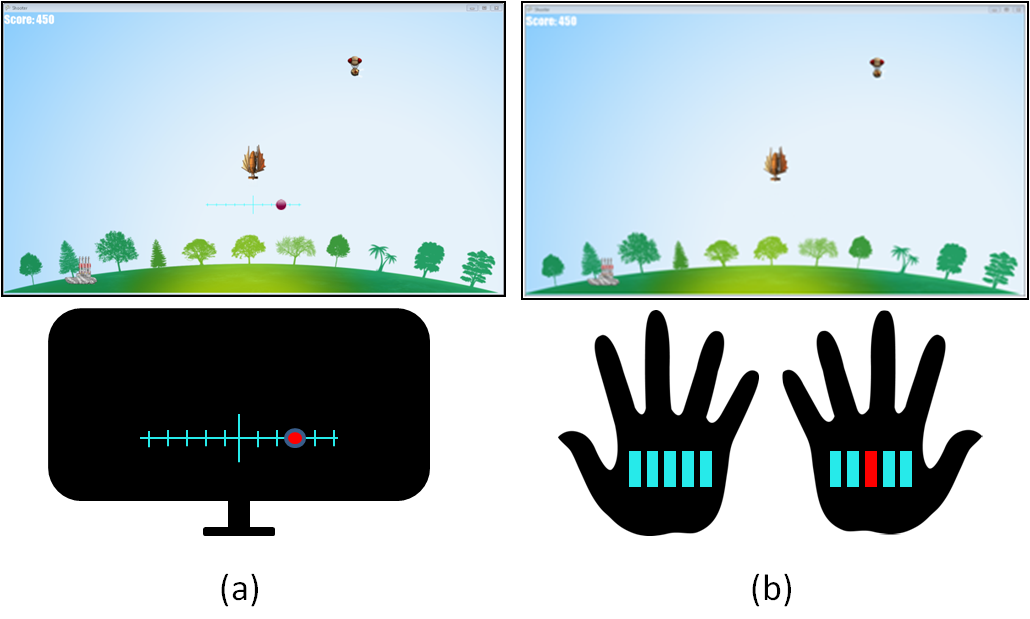Section: New Results
Training Approaches for Brain-Computer Interfaces
Participants : Alison Cellard, Martin Hachet, Camille Jeunet, Fabien Lotte, Christian Mühl, Julia Schumacher.
While recent research on Brain-Computer Interfaces (BCI) has highlighted their potential for many applications, they remain barely used outside laboratories due to a lack of robustness. Spontaneous BCI (i.e., mental imagery-based BCI) often rely on mutual learning efforts by the user and the machine, with BCI users learning to produce stable EEG patterns (spontaneous BCI control being widely acknowledged as a skill) while the computer learns to automatically recognize these EEG patterns, using signal processing. Most research so far was focused on signal processing, mostly neglecting the humans in the loop.
Indeed, even if it has been advocated in one of our previous publications (see activity report 2013) that current human training approaches for spontaneous BCI are most likely inappropriate, based on theoretical models, we still needed practical confirmations that users' modest performances at controlling a BCI could be partly due to these inappropriate training protocols. Thus, in our work, we proposed to study standard BCI training protocols without EEG signals, i.e., without a BCI [31] . In particular, we studied how people could learn to do two simple motor tasks using the same training tasks and feedback as the one given to motor imagery BCI users. More precisely, we asked subjects to learn to draw on a graphic tablet a triangle and a circle (the correct size, angles and speed of drawing of these two shapes being unknown to the subject) that can be recognized by the system, using a synchronous training protocol and an extending bar as feedback, like for motor imagery based BCI training. Our results show that most subjects (out of N=20 subjects) improved with this feedback and practice (i.e., the shapes they drew were increasingly more accurately recognized by the system), but that 15% of them completely failed to learn how to draw the correct shapes, despite the simplicity of the motor tasks. This suggests that part of BCI illiteracy/deficiency is likely due to the training protocols currently used.
From the huge variability in users' performances at BCI mastery emerged the following question: Why do some people manage to learn using these protocols and others do not? Our hypothesis here was that these protocols are not adapted to some users' profiles. Thus, we designed an experiment in which we looked for correlations between the personality and cognitive profile of the users and their ability to learn to control a MI-BCI. Our current results (N=18) show that 1) performances are strongly correlated with users' spatial abilities and 2) we can reliably predict these performances using a model including different psychological factors (like abstractedness, self-reliance or tension). These results are very encouraging as they could lead to reflections about 1) exercices to improve users' spatial abilities and 2) solutions to take into account users' cognitive and personality profiles in BCI training approaches.
Furthermore, it is more and more claimed that visual feedback is not ideal for BCIs as they are conceived for interaction situations in which the visual channel is often overtaxed. Thus, tactile feedback might appear to be more relevant. In order to test this hypothesis, we proposed a study aiming at comparing a standard visual feedback with an equivalent tactile feedback in an appealing training environment containing visual distractors (to mimic an interaction context in which the visual channel is overtaxed). Users had to learn to perform motor-imagery tasks as well as a counting task, and received either a visual or vibrotactile feedback (see Figure 11 ). Our main result (N=18) is the fact that people receiving tactile feedback perform significantly better (at Motor-Imagery and counting task). This kind of result should encourage the BCI community to replace standard BCI protocols by more motivating training environments and multimodal feedback.
|
Still regarding the feedback, we explored what kind of information could help the user to perform better mental imagery tasks. As such, we look for physiological features that could predict whether a mental task will be correctly recognized by the BCI, and that could be understood by the user. Among the different features we explored, it appears that the user's relaxation (from a muscular point of view), as measured in EMG activity collected by EEG channels, is one of such features. We are currently building and exploring new BCI training protocols that provide additional information about the user's muscular relaxation as complementary feedback.



